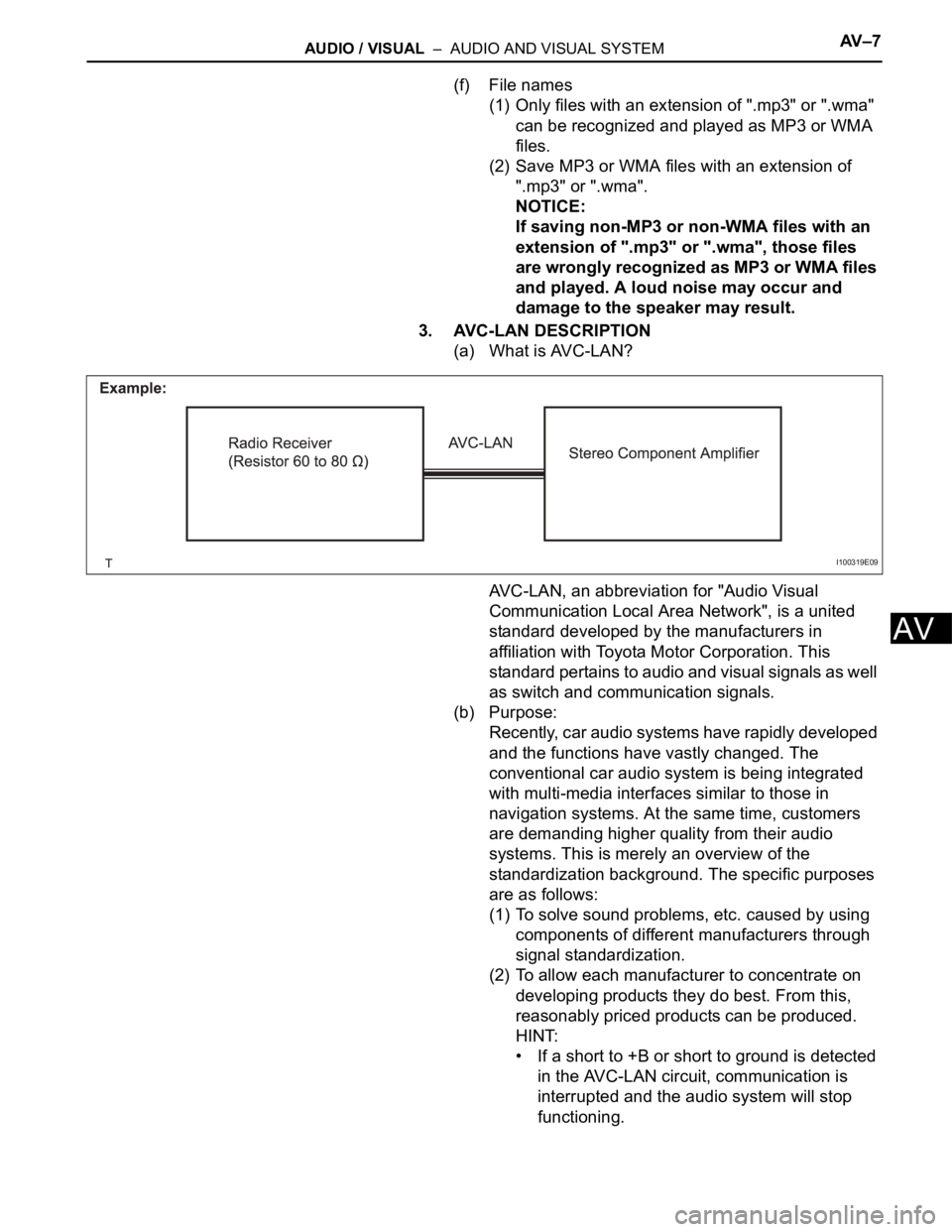Page 51 of 3000

INTRODUCTION – HOW TO TROUBLESHOOT ECU CONTROLLED SYSTEMSIN–39
IN
• In the DTC check, it is very important to determine
whether the problem indicated by the DTC either: 1)
still occurs, or 2) occurred in the past but has returned
to normal. In addition, the DTC should be compared
to the problem symptom to see if they are related. For
this reason, DTCs should be checked before and after
confirmation of symptoms (i.e., whether or not
problem symptoms exist) to determine current system
conditions, as shown in the flowchart below.
• Never skip the DTC check. Failing to check DTCs
may, depending on the case, result in unnecessary
troubleshooting for systems operating normally or
lead to repairs not related to the problem. Follow the
procedures listed in the flowchart in the correct order.
Theft Deterrent System XXXXX
Engine Immobiliser System
XX
Cruise Control SystemXXX
Dynamic Laser Cruise Control System
XXX
Lighting System
XX
Wiper and Washer SystemXXXXX
Power Door Lock Control System X X X
Wireless Door Lock Control SystemXX
Key Reminder Warning System X X XX
Meter / Gauge System X X X
Audio and Visual SystemXXXX
Rear Seat Entertainment System XXXXX
Navigation System
XXXX
Clearance Sonar SystemXXXXX
Rear View Monitor System XXXXX
Power Window Control System (with Jam
Protection Function)XXX
Power Window Control System (without Jam
Protection Function)XXXXX
Power Mirror Control System (with Memory) X X X
Power Mirror Control System (without Memory)XXXXX
Front Power Seat Control System X X X
Rear No. 2 Seat Assembly (with Power Stowing
Function)XXXXX
Window Deogger SystemXXXXX
Power Slide Door System
XX
Slide Door Closer System X X X
Back Door Closer SystemXX
Power Back Door SystemXX
Sliding Roof System XXXXX
Multiplex Communication System XXXXX
CAN Communication System XXXXXSystemSYMPTOM CONFIRMATION AND DIAGNOSTIC TROUBLE CODE
DTC Check
(Normal Mode)DTC Check
(Check Mode)Sensor Check/
Test Mode
(Input Signal
Check)Data List Active Test
Page 69 of 3000

INTRODUCTION – HOW TO TROUBLESHOOT ECU CONTROLLED SYSTEMSIN–39
IN
• In the DTC check, it is very important to determine
whether the problem indicated by the DTC either: 1)
still occurs, or 2) occurred in the past but has returned
to normal. In addition, the DTC should be compared
to the problem symptom to see if they are related. For
this reason, DTCs should be checked before and after
confirmation of symptoms (i.e., whether or not
problem symptoms exist) to determine current system
conditions, as shown in the flowchart below.
• Never skip the DTC check. Failing to check DTCs
may, depending on the case, result in unnecessary
troubleshooting for systems operating normally or
lead to repairs not related to the problem. Follow the
procedures listed in the flowchart in the correct order.
Theft Deterrent System XXXXX
Engine Immobiliser System
XX
Cruise Control SystemXXX
Dynamic Laser Cruise Control System
XXX
Lighting System
XX
Wiper and Washer SystemXXXXX
Power Door Lock Control System X X X
Wireless Door Lock Control SystemXX
Key Reminder Warning System X X XX
Meter / Gauge System X X X
Audio and Visual SystemXXXX
Rear Seat Entertainment System XXXXX
Navigation System
XXXX
Clearance Sonar SystemXXXXX
Rear View Monitor System XXXXX
Power Window Control System (with Jam
Protection Function)XXX
Power Window Control System (without Jam
Protection Function)XXXXX
Power Mirror Control System (with Memory) X X X
Power Mirror Control System (without Memory)XXXXX
Front Power Seat Control System X X X
Rear No. 2 Seat Assembly (with Power Stowing
Function)XXXXX
Window Deogger SystemXXXXX
Power Slide Door System
XX
Slide Door Closer System X X X
Back Door Closer SystemXX
Power Back Door SystemXX
Sliding Roof System XXXXX
Multiplex Communication System XXXXX
CAN Communication System XXXXXSystemSYMPTOM CONFIRMATION AND DIAGNOSTIC TROUBLE CODE
DTC Check
(Normal Mode)DTC Check
(Check Mode)Sensor Check/
Test Mode
(Input Signal
Check)Data List Active Test
Page 259 of 3000

AUDIO / VISUAL – AUDIO AND VISUAL SYSTEMAV – 7
AV
(f) File names
(1) Only files with an extension of ".mp3" or ".wma"
can be recognized and played as MP3 or WMA
files.
(2) Save MP3 or WMA files with an extension of
".mp3" or ".wma".
NOTICE:
If saving non-MP3 or non-WMA files with an
extension of ".mp3" or ".wma", those files
are wrongly recognized as MP3 or WMA files
and played. A loud noise may occur and
damage to the speaker may result.
3. AVC-LAN DESCRIPTION
(a) What is AVC-LAN?
AVC-LAN, an abbreviation for "Audio Visual
Communication Local Area Network", is a united
standard developed by the manufacturers in
affiliation with Toyota Motor Corporation. This
standard pertains to audio and visual signals as well
as switch and communication signals.
(b) Purpose:
Recently, car audio systems have rapidly developed
and the functions have vastly changed. The
conventional car audio system is being integrated
with multi-media interfaces similar to those in
navigation systems. At the same time, customers
are demanding higher quality from their audio
systems. This is merely an overview of the
standardization background. The specific purposes
are as follows:
(1) To solve sound problems, etc. caused by using
components of different manufacturers through
signal standardization.
(2) To allow each manufacturer to concentrate on
developing products they do best. From this,
reasonably priced products can be produced.
HINT:
• If a short to +B or short to ground is detected
in the AVC-LAN circuit, communication is
interrupted and the audio system will stop
functioning.
I100319E09
Page 260 of 3000

AV – 8AUDIO / VISUAL – AUDIO AND VISUAL SYSTEM
AV
• If an audio system is equipped with a
navigation system, the multi-display unit acts
as the master unit. If the navigation system is
not equipped, the audio head unit acts as the
master unit instead. If the radio and
navigation assembly is equipped, it is the
master unit.
• The radio receiver contains a resistor that is
necessary to enable communication on the
different AVC-LAN circuits.
• The car audio system with an AVC-LAN
circuit has a diagnostic function.
• Each component has a specified number (3-
digit) called a physical address. Each function
has a number (2-digit) called a logical
address.
4. COMMUNICATION SYSTEM OUTLINE
(a) Components of the audio system communicate with
each other via the AVC-LAN.
(b) The master component of the AVC-LAN is a radio
receiver with a 60 to 80
resistor. This is essential
for communication.
(c) If a short circuit or open circuit occurs in the AVC-
LAN circuit, communication is interrupted and the
audio system will stop functioning.
5. DIAGNOSTIC FUNCTION OUTLINE
(a) The audio system has a diagnostic function (the
result is indicated on the master unit).
(b) A 3-digit hexadecimal component code (physical
address) is allocated to each component on the
AVC-LAN. Using this code, the component in the
diagnostic function can be displayed.
Page 261 of 3000
AV–200AUDIO / VISUAL – STEERING PAD SWITCH
AV
INSPECTION
1. INSPECT STEERING PAD SWITCH LH (w/o
Navigation System)
(a) Measure the resistance according to the values in
the table below.
Standard resistance
If the result is not as specified, replace the steering
pad switch LH.
Tester connection Condition Specified condition
AU1 - EAU No switch is pushed Approx. 100 k
AU1 - EAU SEEK+ switch: push Approx. 0
AU1 - EAU SEEK- switch: push Approx. 0.3 k
AU1 - EAU VOL+ switch: push Approx. 1 k
AU1 - EAU VOL- switch: push Approx. 3.2 k
AU2 - EAU No switch is pushed Approx. 100 k
AU2 - EAU MODE switch: push Approx. 0
I039169E02
Page 262 of 3000
AUDIO / VISUAL – STEERING PAD SWITCHAV – 2 0 1
AV
2. INSPECT STEERING PAD SWITCH RH (w/ Navigation
System)
(a) Measure the resistance according to the value(s) in
the table below.
Standard resistance
If the result is not as specified, replace the steering
pad switch RH.
Tester connection Condition Specified condition
AU2 (B-4) - EAU (B-2)
No switch is pushed 10 k
or higher AU2 (B-5) - EAU (B-3)
AU2 (B-5) - EAU (B-2)
AU2 (B-4) - EAU (B-3)
AU2 (B-4) - EAU (B-2)
VOICE switch: push Approx. 3.2 k
AU2 (B-5) - EAU (B-3)
AU2 (B-5) - EAU (B-2)
AU2 (B-4) - EAU (B-3)
AU2 (B-4) - EAU (B-2)
ON HOOK switch: push Approx. 0.3 k
AU2 (B-5) - EAU (B-3)
AU2 (B-5) - EAU (B-2)
AU2 (B-4) - EAU (B-3)
AU2 (B-4) - EAU (B-2)
OFF HOOK switch: push Approx. 1 k
AU2 (B-5) - EAU (B-3)
AU2 (B-5) - EAU (B-2)
AU2 (B-4) - EAU (B-3)
E120114E01
Page 263 of 3000
AV–202AUDIO / VISUAL – STEERING PAD SWITCH
AV
3. INSPECT STEERING PAD SWITCH CABLE (w/
Navigation System)
(a) Measure the resistance according to the value(s) in
the table below.
Standard resistance
If the result is not as specified, replace the steering
pad switch cable.
Tester connection Condition Specified condition
B-1 - C-1 Always Below 1
B-2 - C-2 Always Below 1
B-3 - C-3 Always Below 1
B-4 - C-4 Always Below 1
B-5 - C-5 Always Below 1
B-6 - C-6 Always Below 1
B-7 - C-7 Always Below 1
B-8 - C-8 Always Below 1
B-1 - Body ground Always 10 k or higher
B-2 - Body ground Always 10 k
or higher
B-3 - Body ground Always 10 k
or higher
B-4 - Body ground Always 10 k
or higher
B-5 - Body ground Always 10 k
or higher
B-6 - Body ground Always 10 k
or higher
B-7 - Body ground Always 10 k
or higher
B-8 - Body ground Always 10 k
or higher
E120113E02
Page 264 of 3000
NAVIGATION – NAVIGATION SYSTEMNS–3
NS
SYSTEM DESCRIPTION
1. Radio and navigation assembly outline
(a) Conventionally, 2 separate devices, a "radio and
display" and a "navigation ECU" are used. This
model has adopted a new type, combining these
devices into a single unit.
E120051E01